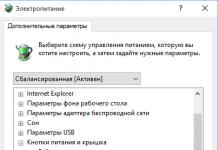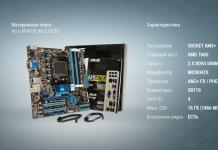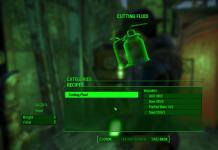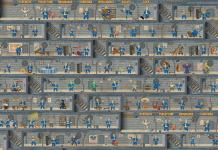In this very important and useful article I will tell you how to transfer the “My Documents”, “Downloads” and “Desktop” folders from the system drive (C:) to another and why is it generally advisable for all users to do this immediately after installing the Windows operating system.
In fact, transferring these system user folders is very simple and easy; it is much more important to understand why it is desirable to do this.
My task in this article is to convince you of the feasibility of this operation and its necessity.
Table of contents:
Why migrate user folders?

Here are a few reasons why I strongly recommend that you move the “My Documents”, “Downloads” and “Desktop” folders from the system drive (C:) to another...
The first reason is that their content very quickly and heavily fills the “C” drive with secondary files, which slows down the system over time...


The fact is that for normal, fast operation of the Windows operating system 10% free space required on your disk.
Most computer programs shove the fruits of their work into the “My Documents” folder by default. For example, photo and video editors.
All browsers by default save files you download from the Internet to the “Downloads” folder, which is located on the system drive.
Read also on the website:
In general, everything is very bad with the “Desktop” folder. For many years, I have not been able to convince even one user (even my own wife) to give up placing movies and photo albums on the desktop. And this is understandable - it’s just more convenient for everyone.
Maybe someone didn’t know that when you “throw” a film of several gigabytes in size onto the desktop, among the shortcuts, you thereby place it in the “Desktop” folder, which is “mounted” in the system drive?
The second reason is that after your operating system suddenly quietly dies from abuse, it will take all your downloads, projects, saved programs and games to the land of cartoons...
If you transfer the “My Documents”, “Downloads” and “Desktop” folders to another drive, all your documents and files will truly become YOUR documents and files. After reinstalling the system, they will remain the most alive.
The third reason will be useful to owners of SSD drives. By transferring these folders, you will extend the life of your favorite hustler.
I already wrote that these fast drives have a limited number of write cycles. So, the frequency of data overwriting in these three folders breaks all records... take pity on the miracle of technology - move the “My Documents”, “Downloads” and “Desktop” folders to a second, regular hard drive.
We can continue to list the reasons, but I think it’s time to move on to practice.
How to move the “My Documents” “Downloads” “Desktop” folders
If you noticed, I called these three folders system folders a couple of times. This means that simply dragging it with the mouse to another drive (like regular folders) will only copy them, not move them. There will be no changes in the system registry and it will continue to “see” them on its disk.
I already said above that moving these system user folders can be very simple, so don’t be afraid of anything and feel free to proceed...
First we need to create, let’s say on the “D:” drive, new folders “My Documents”, “Downloads” and “Desktop”...


In order not to clutter up the disk with “extra” folders (and accidentally delete them after a while), I created one “Users” folder and placed the heroes of this article in it.
Let me remind you that you can create a folder by right-clicking anywhere and selecting “Create” - “Folder” in the context menu that appears.
Now go to the system drive “C:” and find the “Users” folder (I have Windows 7 (🙂))…


In it we find a folder with our system user name and there we find the heroes of the occasion...


Further actions are identical for all folders, so I show them using the example of one - “My Documents”.
Click the RIGHT mouse button on the folder and go to “Properties” in the context menu...


...go to the “Location” tab and click “Move”. The system will ask where to move it - indicate our new folder “My Documents” on drive “D:”...


Oh, screenshot with “Desktop”, but nothing, I hope you understand what needs to be specified?
Be careful - you need to specify “My Documents” by clicking on it (it should be empty).
Now all that remains is to click on “Select folder”. In the folder properties window, the path to it will change - click on “Apply” (and not again on “Move”) and agree to transfer all the contents...




Congratulations, you moved the “My Documents” folder to another drive - it disappeared from the old location and in the new one even its label has changed from a simple folder to a system one.
We do the same with all our remaining two folders.
All that remains is to check the result of the transfer - for example, go to the properties of any shortcut on the desktop and look at its location...


Everything is correct and wonderful.
Now you know how to transfer the “My Documents”, “Downloads” and “Desktop” folders. This procedure can be done at any time, but it is highly advisable immediately after installing the new system.
If you reinstall the Windows system, you must repeat the procedure described in the article and indicate your saved folders on the “D:” drive.
To new useful computer programs and.
USEFUL VIDEO
I'm just reviewing programs! Any complaints - to their manufacturers!
Once upon a time, at the very beginning, I wrote a couple of articles on this topic, these were articles about transferring the “My Documents”, “Downloads” folders, the Appdata folder and even the entire user profile. It turned out, of course, not very beautiful (the first pancake is always lumpy :)), so someday I will completely rewrite these articles. And although all folders are transferred in a template manner, remembering search engines, I will write a couple more articles: this one, about moving the desktop, and about moving the “Downloads” folder. Remembering to save the SSD drive, these actions will not only free up space on the system drive, but will also extend its uptime. So, let's get started with the operation. Just like with other system folders, there are two ways to transfer this folder:
I. Through the conductor
II. Using Registry Editor
I. Transferring your desktop through Windows Explorer
1) The first thing you need to do is create a folder that will be used to store files and desktop shortcuts:
C:\Users\*username*
We find ourselves in a folder containing the following: 
3) Right-click on the “Desktop” folder and open its properties: 
4) Go to the “Location” tab and click the “Move” button: 
5) Go to our folder created in the first step and press the “Select folder” button: 
6) Click the "OK" button to apply the changes: 
And we agree to transfer files and folders by clicking “Yes”: 
7) Files and shortcuts have been successfully moved, and now everything you save to your desktop is saved on another partition. 
II. Transferring your desktop by making changes to the registry
1) Open the Windows Registry Editor. To do this, press the key combination Win+R and enter regedit :
2) We follow the path:
HKEY_CURRENT_USER\Software\Microsoft\Windows\CurrentVersion\Explorer\Shell Folders
Moving your desktop to another drive such as "D" is not difficult and in addition you will get several advantages from it. As a rule, for most users, the system drive C:\ does not have such a large amount of memory, and as you know, all files located on the desktop occupy the space of this particular disk, and accordingly, by moving the desktop to another disk, the memory on it will be freed up. And this is of course not the only plus.
Also, transferring your desktop to another local drive helps save your data, namely the files located on it in the event of a serious failure of your system. That is, if you need to reinstall Windows due to a system failure, you will not need to resort to transferring all the files on your desktop, since they will all be located on another drive. By the way, using the method described in this article, you can transfer folders My documents And downloads in the same way, the necessary files can also be stored in these folders.
How to move your desktop to another drive
Moving a desktop to another drive looks the same in all versions of Windows, with the exception of XP. So, first, let's go to the local drive C:\, then we are interested in the users folder.
Here we open the folder with the name of your account, in my case it is the .

Finding the folder Desktop and go to its properties.

In the properties window that opens, we are interested in the tab location. The line shows the path where our desktop folder is located, and we need to change it.

To change the location, you need to enter the desired path pointing to another local drive, or select the desired location folder by clicking on the button move. Then press the button apply.

If the folder on another drive has not yet been created, you will be prompted to create it, where we click yes.

Next, the system will display a message about moving all files to a new folder, where we also agree to this by clicking on the button Yes. The process of transferring all your desktop data to another drive will soon begin.

Transfer your desktop to another drive using the windows registry
There is another way to transfer your desktop to another local drive by changing a value in the Windows registry. To do this, open the registry key combination +R, where we enter the command regedit and press OK.

In the editor that opens, follow the path HKEY_CURRENT_USER\Software\Microsoft\Windows\CurrentVersion\Explorer\User Shell Folders. Where to open the parameter Desktop and enter in the field meaning new desktop path.

ABOUTGive your opinion about this article, and of course, ask your questions if something suddenly goes wrong for you.
Thank you for your attention!
The Windows operating system stores the “Desktop” folder with program shortcuts located in it on its installation drive (usually drive C). In the event of a serious failure, the user may lose their conveniently configured desktop. To prevent this from happening, you can move it to another drive.
Posting sponsor P&G Articles on the topic "How to move the desktop to drive D" How to install Windows XP on another drive How to move the desktop to another drive How to get back the My Documents folder
Now the important folder: Internet cache! Why store them elsewhere? In the area associated with Temporary Internet Files, click the Settings button. Click the "Move Folder" button and select another partition! Make sure you are there and set the cache size.
Oh, this is usually available in other browsers too. Leaving it in a folder on another partition can do a lot to make the system partition clean and stable. This tip is good to use as soon as you install the operating system, before installing many applications.
Go to My Computer properties, click the Advanced tab, and click the Environment Variables button. Additional advice, and it is also important to maintain the stability of the system drive: move the page file to another drive. And this avoids fragmentation of the main block with temporary files that are only useful for a while, for example, when installing a program or rotating it.
Instructions
If Windows is installed on drive C, the path to the desktop will be: C:Documents and SettingsAdminDesktop. In this example, the username is Admin; yours may be different. To move your desktop to another drive, use Windows Explorer. Click Start, then open All Programs - Accessories - File Explorer. Next, open in Explorer: C: Documents and SettingsAdmin and select the “Desktop” folder. In the menu, select “Edit” - “Move to folder...” and specify the location where you want to move the desktop - for example, just select drive D. The folder will be moved. After this, be sure to restart your computer. Please note that you can only move the desktop through Windows Explorer and nothing else. Do not move the Desktop folder by simply dragging it with the mouse or using various file managers. When you move the desktop through File Explorer, the operating system remembers its new location, so you won't have any difficulties in the future. It is possible to move the desktop by editing the system registry, but this option is much more complicated, so there is no point in using it; it is much more convenient to use Windows Explorer. In addition to the desktop, it is useful to store the “My Documents” folder on another drive. In this case, you can save files in it without fear of Windows crashing, since your data and the operating system will be on different drives. To transfer this folder, click “Start”, right-click the “My Documents” line in the menu. In the context menu that opens, select “Properties”. The properties window will open, in it click the “Move” button. In the new window, select the desired drive and create the “My Documents” folder. Click OK and you will be asked to confirm moving the files. Agree by clicking “Yes” and the file transfer will begin. After it finishes, restart your computer. Please note that all applications must be closed when transferring files. How simple
Other news on the topic:
Why change the user folder location?
And it can benefit you in many ways.
Ability to use two disks on one computer
Use your drive on different computers. Do you know when we are about to format a machine and wonder if we are copying everything or not? Well, if the user's folder is in a different location, you don't have to think twice.For example, I have some operating systems on my computer. There were some situations above, but each of them may have a specific application. First, we need to define. Assuming we have three users. All these folders are created in the Users folder. Inside the folder users we will have three folders: Ana, Carlos and Clara.
When reinstalling the operating system, the issue of restoring the selected settings is relevant. This includes installing the necessary software, desktop design and screensavers, as well as restoring files and folders in the “Desktop” and “My Documents” system folders. To you
The Microsoft Windows operating system provides the ability to transfer the Desktop component, which is part of the user profile, to another partition of the computer disk. This operation is carried out using standard system tools. Sponsor of P&G placement Related articles
Ways to change the location of your personal files
Now that we understand what we are going to do, let's move on. We have two simple ways to change.
Using the program to change the user folder
Then know that only profiles created after running the program will be saved elsewhere.The program is free, small and has. Just continue and order as needed. Proceed at your own risk. Place a destination for new users and click Start. After some time, the process completes successfully.
As you guessed, today we’ll talk again about setting up your computer and operating system. To be more precise, I want to tell you about how you can move, in different types of Windows, the folder in which “ Desktop" And " My Documents"to disk" D:\».
Perhaps you may be wondering why this is necessary? There are so many reasons for this that you don’t need to think long about it. Every day, someone and for-for or such flies Windwos or file system, which leads to or.
Now you need to either log out or restart. Click Manage Another Account. Then click "Add New User" in your computer's settings. He's gray, like he's disabled, but he's not! Click "I don't have this person's login information."
Please note that we have not posted any user information until now. Now enter your username and if you want to enter a password, click Next. Typically the account you create does not appear as "Administrator - Local Account". If you want this user to have administrator rights, click "Change account type" and select "Administrator".
Such cases often lead to the loss of important files that were stored on the “C:” drive, in the desktop and document folders. Of course, you can try those that were lost, but after they are restored they may be damaged. Well, disappointed users, with sadness before their eyes, begin to reinstall the system.
In this article, I will show you how you can prevent yourself from losing important files when Windows is damaged. I’ll also show you in detail, how to move the “Desktop” and “My Documents” folders for storage, on the “D:\” drive, so that later, after installation, you don’t have to worry about losing them.
Accounts with an administrator profile can make changes to the system, such as installing and removing programs, changing advanced settings, and others. User accounts do not have these permissions. In fact, it completely recreates the users folder structure, creating default system folders as well as our new account.
Just to be clear: this procedure does not transfer old accounts to the new destination. This new destination will only be used for new user accounts. So if you want to transfer the old one, you must create a new account and move the files there.
Moving Desktop and My Documents Folders in Windows XP
So, to change the location in Windows XP we need, you can see how to do this here. Now, in the registry that opens, go to the following branch:
HKEY_CURRENT_USER\Software\Microsoft\Windows\CurrentVersion\Explorer\Shell Folders
Pressing " Shell Folders» A large list of different properties and values will appear on the right. Here, we look for those folders in which we want to change their storage location. So, we move “Desktop” and “My Documents”, respectively, we find the items “” and “”.
Manually changing a user's profile folder
The second, much simpler but less effective option is to change only a few local folders. First, you can create a folder with any name on another drive. Then we will find the folder to move. Already registered user you want to change the folder location, right-click the Quick Access folder, for example, under Downloads and open Properties.
Part 2: Moving All New Content
On the Local tab, enter a new location for this folder. So you can move all those folders there. But it must be one after the other, individually. This significantly increases productivity. Updating an old backup or creating a new backup will ensure that all content is transferred correctly and will simplify the transfer process. This way, all content added to the new computer will be separate from the old library.
By clicking on “” twice, in the window that opens, enter a new value, namely the path where our desktop will be stored.

We do the same with “”, open and enter the folder address. For example, I will store folders immediately in the root of the drive “D:\”, accordingly I will write the following value: D:\My Documents. If this is some other folder on the disk, then the path will look something like this: D:\Folder name\My Documents.
Files can be added back to the library. Follow these steps to copy all your media files, including the library file that stores all your playlists and other settings, to your new computer.

You've now moved all your music, playlists, and other information, including game counts and ratings, from your old computer to your new one.
Part 4: Re-adding new content
After transferring the library
After logging into the user account you transferred. If you have problems with data transfer. If the above steps do not work properly, please follow these steps. Follow these steps to prevent other applications from opening during migration.
By clicking " OK», save the changes made. And in order for them to fully take effect, you must restart the computer. After this, everything that you save on your desktop will be automatically duplicated in the above-mentioned folder on the “D:\” drive.
Disable antivirus software
If it doesn't appear, make sure the computers are connected to the same network. Once the migration is complete, you can enable the firewall software. Then try opening the Migration Wizard again. Once the migration is complete, you can activate your antivirus software.
If your computer doesn't support Migration Assistant
There are other data transfer options. See what exactly can be downloaded from applications and what types of data. Email, contact and calendar information. Migration Assistant moves your email settings, email account settings, contacts, and appointments.
Changing the desktop storage location on Windows 7 and 8
In the situation with Windows 7, everything is much simpler. To do this, we do not need to go into the registry or manually change the storage location of the user folders. All we have to do is simply select all the folders and cut them out.

Risks are inherent in using the Internet. For more information. Other company and product names may be trademarks of their respective owners. We'll show you four methods you can use to copy your files and settings to a new computer without much effort.
The advantage of this option is that you don't need to download any software or follow any special instructions. But there are two points you need to pay attention to. First, the media must have enough space for all the files you want to transfer, or you will have to make multiple "trips." And in addition to helping you transfer files, it can be used to store your backups for the future.
Then, go to the desired folder on another drive and paste them there. After copying is completed, restart the computer and check the result. To do this, having created any file on the desktop, it should appear in the copied folder. If so, then everything was done correctly.

Another thing is that you need to manually select the files you want to transfer. You will also find a Desktop folder there, which contains all the files and folders that are on your desktop. If you don't save your documents in the My Documents folder or one of your subfolders, find them using your file manager and copy them to external media.
This can be a convenient way to transfer documents, but keep in mind that transferring large files can take a long time and eat up a good chunk of the monthly data allowance on your broadband plan, if you have one. Online storage, as well as removable storage, requires you to manually select files to upload. And if you don't feel confident enough, you may prefer one of the two automatic approaches.
Thanks to the fact that we will transfer the folders to another local drive, we can protect ourselves from losing our files. And let's not bother with this during the next Windows update. By the way, I regularly use transferring user folders at work, and I want to say that this has saved me more than once in various situations. Thanks to the fact that I moved the desktop to another drive, I saved a huge amount of time that I could have spent on restoring files. So, think about whether you should change your storage location or not?
Option 3: This application basically does what we have described in the previous methods, that is, transferring the contents of each user's folders, as well as transferring user accounts and their associated settings. If you wish, you can protect your backup with a password. The tool will automatically copy your documents, bookmarks and other user data to the desired locations.
Simply download and install the program on both computers. Don't forget your product keys. If you have software that you paid for, you should remember to return it. This way, you can download, install, and reactivate the software on your new machine without having to buy a new copy of the software or contact your developer.
Once upon a time, at the very beginning, I wrote a couple of articles on this topic, these were articles about transferring the “My Documents”, “Downloads” folders, the Appdata folder and even the entire user profile. It turned out, of course, not very beautiful (the first pancake is always lumpy :)), so someday I will completely rewrite these articles. And although all folders are transferred in a template manner, remembering search engines, I will write a couple more articles: this one, about moving the desktop, and about moving the “Downloads” folder. Remembering to save the SSD drive, these actions will not only free up space on the system drive, but will also extend its uptime. So, let's get started with the operation. Just like with other system folders, there are two ways to transfer this folder:
I. Through the conductor Windows
II. Using Registry Editor Windows
I. Transferring your desktop through Windows Explorer
1) The first thing you need to do is create a folder that will be used to store files and desktop shortcuts:
2) Next, go to the user’s folder. If in Windows 7 it was quite simple (you just need to open Start and select the username in the right column), then starting with Windows 8 you need to go the following way:
C:\Users\*username*
We find ourselves in a folder containing the following: 
3) Right-click on the “Desktop” folder and open its properties: 
4) Go to the “Location” tab and click the “Move” button: 
5) Go to our folder created in the first step and press the “Select folder” button: 
6) Click the "OK" button to apply the changes: 
And we agree to transfer files and folders by clicking “Yes”: 
7) Files and shortcuts have been successfully moved, and now everything you save to your desktop is saved on another partition. 
II. Transferring your desktop by making changes to the Windows registry
1) Open the Windows Registry Editor. To do this, press the key combination Win+R and enter regedit :
2) We follow the path:
HKEY_CURRENT_USER\Software\Microsoft\Windows\CurrentVersion\Explorer\Shell Folders
And we are looking for a parameter Desktop:


























